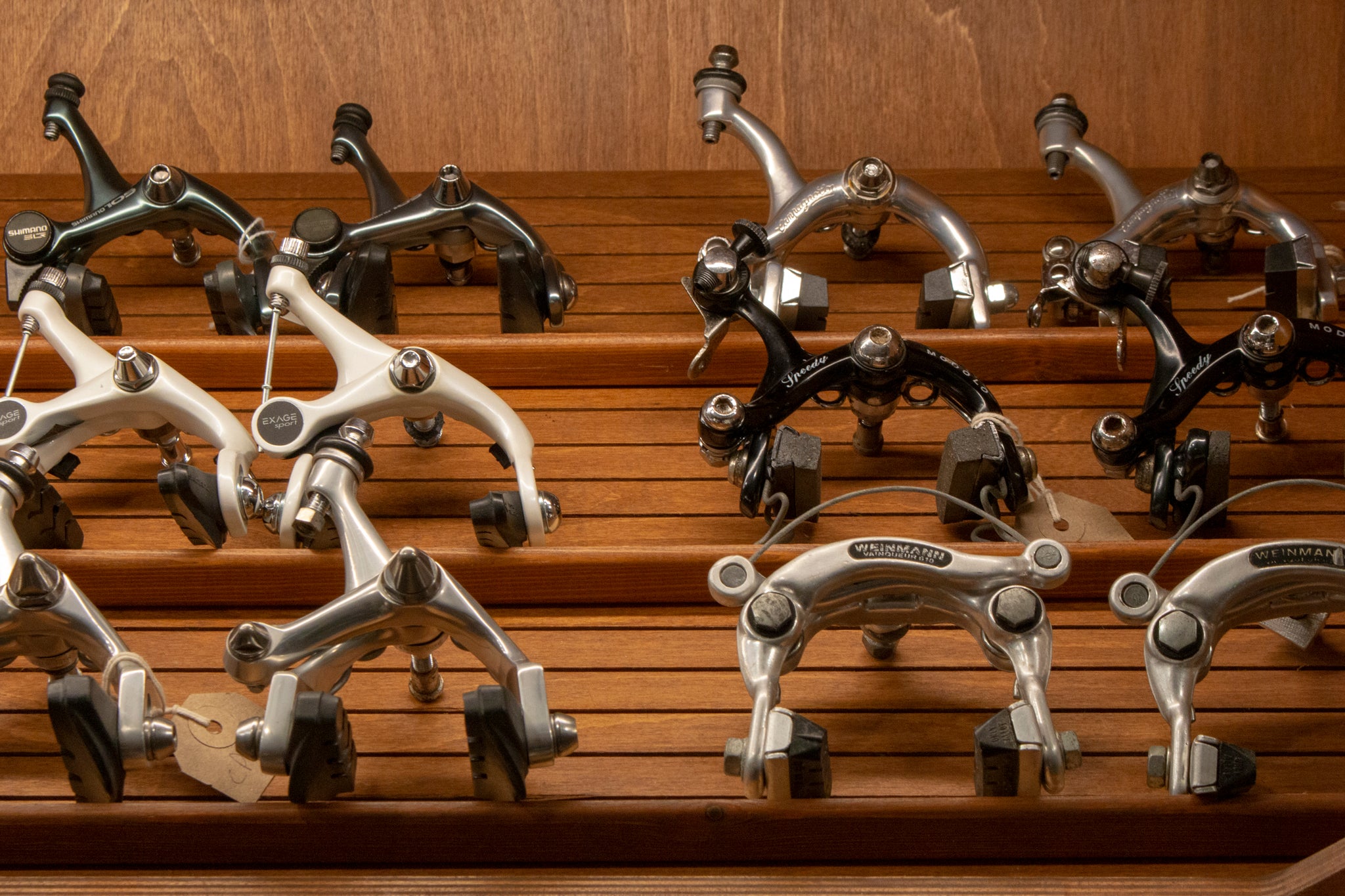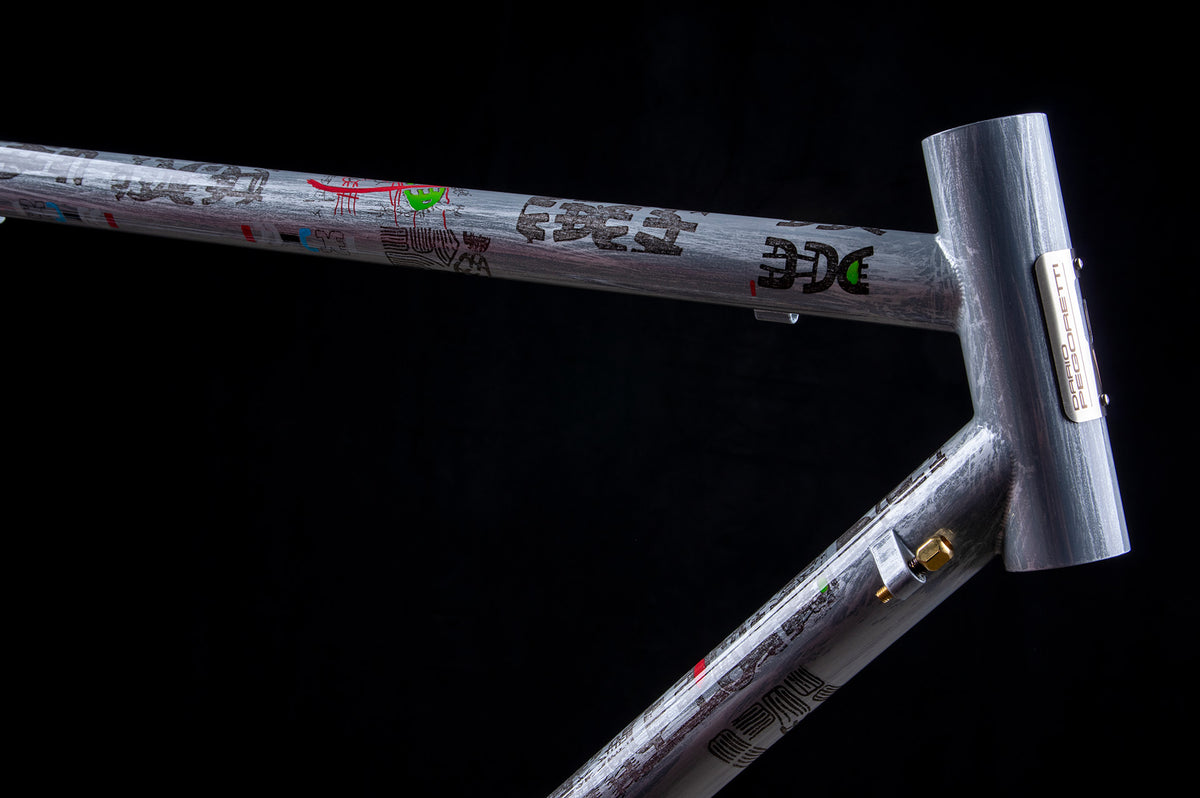
How To Get The Right Brakes For Your Vintage Bike
We are often asked what brakes are needed for classic & vintage bike builds, there are two main points to attend to: what brake and/or fixing type is required; and the brake drop (for caliper brakes).
The easiest way to determine what type of brake you need is to look at how the frame is built and what fixings are present. It is easiest to have a set of appropriate wheels installed in the bike to do this. If the frame has two brazed on posts at 90 degrees to the rear stays and fork then these will either be for cantilever brakes, U brakes or a braze on for centre pull (or sometimes people use the brand Mafac) style brakes.
 It was common in the early days of mountain bikes to have a mix of cantilever and U brakes.
It was common in the early days of mountain bikes to have a mix of cantilever and U brakes.
If the brake pivots are lower on the frame and fork than the rim of the wheel then the bike is designed for cantilever brakes, if they are above then they will be for U brakes or centre pull brakes. The U brake was a short-lived invention that appeared almost exclusively on 26” wheeled mountain bikes, so if you have a mountain bike for 26” wheels and the fork pivots are above the wheel rim then you will need a U brake (or a Rollercam brake). Often the rear brakes on these bikes were on the chainstays not on the seatstays so if the pivots are further forwards than the wheel rim this is for a U brake too.
 Cantilever brake posts sit just below the level of the rim, Mafac and U brake posts sit just above it.
Cantilever brake posts sit just below the level of the rim, Mafac and U brake posts sit just above it.
Cantilever brakes appeared on bikes as early as the 1920s but these older bikes will not accept one of the more easily available and relatively modern cantilever brakes. The use of cantilevers picked up again in the 1970s on touring bikes and really took off with the mountain bike boom in the 1980s. Cantilevers come in various shapes and sizes, and if you have a touring bike it may be that you will need to do some measuring to make sure you get a brake that will work with the bike.
Older touring bikes have a post spacing in the region of 55 to 65 mm from centre to centre, whilst the newer spacing is normally between 77 and 85 mm. While it is possible to fiddle to some extent with pad spacing, or to use a different type of rim brake in some instances (such as a ‘V brake’) your best bet with the narrower spacing is to use an older cantilever designed for it, such as a set of Mafac cantilevers. If your frame and fork are of the wider spacing then it is possible to use a wide variety of cantilever brakes, some of which are still made today, or even a V brake.

A Mafac style centre pull brake made by Universal.
If your bike does not have these brake pivots brazed onto the frame but instead a central hole in the fork crown over the wheel and in the frame above the rear wheel then the bike takes a caliper brake of some description.

A standard drop Campagnolo road caliper brake
Most commonly road bikes will have a side pull brake caliper, either single or dual pivot (if using dual pivot Shimano brakes it is wise to match the SLR type to levers and brakes for the best performance) depending on the age of the bike that mounts either with a recessed allen key nut or a standard external hex nut. The recessed allen key fitting and external hex nut fitting are not always cross compatible, so check the frame carefully to see which size opening you need: if the hole in the frame or fork at the opposite side to the brake is around 6mm then you need an external hex nut brake, if it is around 8mm then you need a recessed allen key brake. More modern dual pivot brakes are designed The most important thing to clarify with these brakes is to determine the ‘brake drop’ which is basically how far down the brake needs to go to allow the pad to engage with the rim properly.
 Caliper brakes mount either with a recessed allen key nut (as above) or an external hex nut (below).
Caliper brakes mount either with a recessed allen key nut (as above) or an external hex nut (below).

Measuring brake drop
With your wheels in the frameset, measure in a straight line from the centre of the hole in the fork or frame to the centre of the rim with a straight edge ruler or Vernier calipers.
 You can check your brake drop requirements by measuring the distance between the brake hole centre and the rim.
You can check your brake drop requirements by measuring the distance between the brake hole centre and the rim.
You can check the drop of a caliper by measuring the distance from the centre of the attachment bolt to the centre of the brake pad (in it's upper and lower positions) in a straight line as shown below too. This will give you a distance (normally expressed in millimetres) for you to use to pick the right brake. For instance if your measurement is 50 mm then any brake with 50 mm in the range will work, so a brake with a drop of 46 to 58 mm will work, but a brake with a drop of 39 to 49 mm probably won’t.
 Measuring the brake drop of the brake will let you know if it fits before installing it on your bike.
Measuring the brake drop of the brake will let you know if it fits before installing it on your bike.
All brakes with a central mount require the brake drop to be measured like this, including centre pull brakes like the Mafacs that were extremely popular through the 1960s and 1970s. These brakes require slightly different cable routing as the main brake cable needs to run down to the centre of the brake and then pull on a straddle cable which actuates the brake, in the same way as a cantilever or rollercam/U brake. They will usually have a hanger at the front mounted to the headset and one at the rear either built into the frame or on a hanger mounted from the seat bolt.
|
Frame braze-ons |
Frame cable routing |
Brake type |
|
Pivots at 90 degrees to the fork blade/seatstay above/forwards of the wheel rim |
Cable is routed central to the frame at the rear or has a hanger on the headset at the front |
U brake or Rollercam |
|
Pivots at 90 degrees to the fork blade/seatstay below/behind the wheel rim |
Cable is routed central to the frame at the rear or has a hanger on the headset at the front |
Cantilevers / V brakes |
|
No braze-ons but a central hole in the fork crown and at the rear of the frame |
Cable is routed central to the frame at the rear or has a hanger on the headset at the front |
Centre pulls such as Mafac |
|
No braze-ons but a central hole in the fork crown and at the rear of the frame |
Cable can route either side at the rear, or has no guide at the front |
Standard road caliper brakes (recessed allen key or hex nut fixing) |
This table should help you further identify what type of brakes you require, of course we haven’t covered disc brakes, hub brakes, drum brakes or tandem drag brakes here, maybe another time...!
If you enjoyed this article please don't forget to share it around 😊
Leave a comment
Comments will be approved before showing up.
Also in The Journal

Eddy Merckx - The Cannibal

Art & Bicycles – Dario Pegoretti - An Italian Master


Roly Seaton
Author